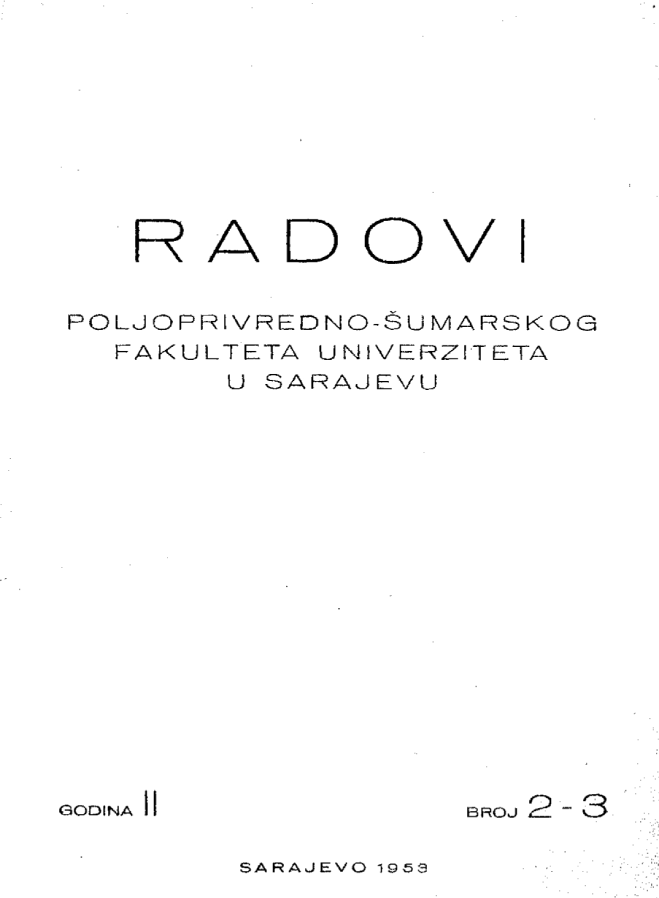UPOREDNI GUBICI PRI JEDNOFAZNOM I VIŠEFAZNOM SREĐIVANJU LETINE OZIME PŠENICE
DOI:
https://doi.org/10.54652/rsf.1953.v2.i2-3.325Abstract
The harvesting in one stage was effected by the Massey-HarrisSelf Propelled Clipper Combine, while sickles, scythes, a self-rake reaper (Cockshutt Plow C° Ltd, Brantford) as well as a grain-binder („Albion”) were all made use of in doing the same job in several stages— the first
stage being the rasping and gathering, and the final one the threshing, for 'which a threshing-machine (Hofherr-Schrantz-Clayton-^Shuttleworth, HSE) was used. The results shown in this report concerned with fixing the comparative rate of wastage due to action of tools and machinery at work take account of and bear reference to the biological yield of winter-wheat, (marked A) just before the start of harvesting, the amount of which has been assessed by adding the losses Wo, and W v to the c \ (Wo stands, for loss before harvesting due to strewn grain, W ï for loss by reaping and gathering, W v by threshing, and CJ, represents the actual amount of grain discharged by the combine) The respective amounts of the yield realized and losses suffered have been converted into 100% pure and undamaged
grain wit humidity content of 12%. For the purpose of forming an estimate of the quality and performance of different machines (the combine and the stationary thresher) the loss by threshing has been worked out in relation to Am as well (the „Am ” represents the quantity of grain got into the:
thresher). All losses due to winter-wheat harvesting — in one or several atage& alike — have been dividen into groups as follows:
- a) W o —- loss before harvesting (due to strewn grain ao; due to* strewn ears and spikelets), which are unaffected by the action of machinée used and have, therefore, not been considered in comparing rates of wastage;
- b) Wx — loss by reaping and gathering, due to cutting of (plants, operational action of tools or harvesting apparatus of machines (a'a), due to manual or machine sheaving, binding, piling and 'throwing about of cheaves (a"*). The above-mentioned losses could be reduced to a certain extent by stubble-raking and gleaning (a'"3). In each of these groups the comparative rates of a el and b el , (amounts of free, scattered grain), a nž (amount of' grain in unreaped ears), a pi (amount, of grain in reaped but uncollected, ears) and b pi respectively have been definitely fixed;
[c) Wv —■ loss by threshing;
,d) Wmt — loss in the interim stage between reaping and thrashing: (where the harvesting was effected in several stages).
The results have shown that Wo (loss before harvesting) in the case of Bankut variety is comparatively slight under normal conditions, amounting as it does to 4,27 kg. per ha, or to 0,159 percent of the biological yiéiLd A (2684,00 kg per ha). To reduce these losses (particularly those due to belated,
harvesting) and to encourage the widest possible use of combines in our agriculture calls for a considerable effort and comprehensive work in selecting and popularizing those varieties of wheat which are distinguished, other properties apart, for their contemporaneous maturation, uniformity of stalks and resistance to strewing or scattering (before, during and after harvesting) when fully mature or over-ripe. Wastage and loss by harvesting (Wx ) are fairly uniform under normal conditions:
kg/ha
% of A
combine
79,68
2,96
reaper
73,79
2,75
binder
73,28
2,73
scythe
74,82
2,78
sickle
46,64
1,74
Downloads
References
Anfiilovjev A:, Voprosy i'-azdaTnoj uborki zernovyh kul’itur v Sibir. Social is tičeskoe sel’skoe hozjajstvo, № 5, 1949,
»Allis-Chalmers All Crop >60«, Combine Harvester«, Farm Mechanization, Vol. Ill, № 28, London, 1951.
Bosanac E., »Gubitak i lom 2rna kod vršalice s uzdužnim ulaganjem žita«, Arhiv Min. polojprivrede, god. IV, sv. 9, Beograd, 1937.
Brownlee Davidson J., »Agricultural Machinery«, p. 202, New York, 1931, (Third Printing, London, 1944).
Capek D.s »Poravnavanje zemljišta«, »Vojvođanski poljoprivrednik«, Br.16, Novi Sad, 1950. -
»Combine Harvester Service — The Massey-Harris № 726«, Farm Mechanization, Vol. I, № 3, London, 1949.
Harris Pearson Smith, »Fax'm Machinery and Equipment«, p.349, New York and London, 1937.
Kaparulin K. N., Turbin, B. G, Serskohozjajstvenye maâiny. Ogiz-SePhozgiz, Moskva, 1946.
Kogan E., Sistema masyn dlja uborki zernovyh kultur v stepnyh rejonah sev. Kavkazi i SSSR, Socialističeskoe sePskoe hozjajstvo, № 9, Moskva 1949.
Letošmev M. N., SePskohozjajstvenye masiny, SePhozgiz, Moskva 1936.
Lomejko S., »Dozrevanje zrna ozime pšenice posle žetve«, Arhiv Minpoljoprivrede, god. IV, sv. 8, Beograd, 1937.
Nikitenko I., O isrokah i siposobah uborki zernovyh kuPtur. Socialist češkoe sel’skoe hozjajstvo, № 5, Moskva, 1948.
Nikitenko I. T., UniversaPnaja žatvenaja mašiina, Sel’hozmašina, № 2, Moskva, 1949.
Polevickdj K. K., SePhozjajstvenye masiny i orudija, Ogiz-SePhozgiz, Moskva, 1946.
Setting Up Instructions and Service Manual for the Massey-Harris Self Propelled Clipper Combine, Racine, Wisconsin, U. S. A.
»The International B-64 Combine Harvester«, Farm Mechanization, Vol. IV, №44, London, 1952/
»The Massey Harris 750 Combine Harvester«, Farm Mechanization, Vol. IV, № 42, London, 1952.
»The M. M. 69 Combine Harvester«, Farm Mechanization, Vol. II, № 16, London, 1950.
»The New Marshall Model 626 Combine Harvester«, Farm Mechanization, Vol. IV, № 36, London, 1952.
W. F. W., S. N., »Moisture Content of Combine Harvested Grain«, Agricultural Engineering Record, Vol. 2, № 7, London, 1949.
W. H. C., »Combine Harvester Design«, Agricultural Engineering Record, Vol. 2, № 6, London, 1948-49.























